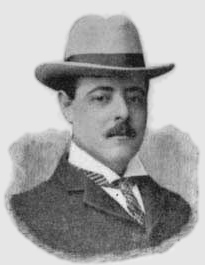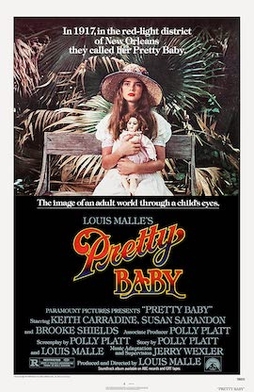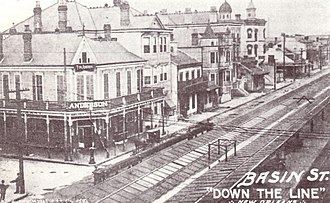
Ferdinand Joseph LaMothe, known professionally as Jelly Roll Morton, was an American ragtime and jazz pianist, bandleader, and composer of Louisiana Creole descent. Morton was jazz's first arranger, proving that a genre rooted in improvisation could retain its essential characteristics when notated. His composition "Jelly Roll Blues", published in 1915, was one of the first published jazz compositions. He also claimed to have invented the genre.

Storyville was the red-light district of New Orleans, Louisiana, from 1897 to 1917. It was established by municipal ordinance under the New Orleans City Council, to regulate prostitution. Sidney Story, a city alderman, wrote guidelines and legislation to control prostitution within the city. The ordinance designated an area of the city in which prostitution, although still nominally illegal, was tolerated or regulated. The area was originally referred to as "The District", but its nickname, "Storyville", soon caught on, much to the chagrin of Alderman Story. It was bound by the streets of North Robertson, Iberville, Basin, and St. Louis Streets. It was located by a train station, making it a popular destination for travelers throughout the city, and became a centralized attraction in the heart of New Orleans. Only a few of its remnants are now visible. The neighborhood lies in Faubourg Tremé and the majority of the land was repurposed for public housing. It is well known for being the home of jazz musicians, most notably Louis Armstrong as a minor.
Johnny Dodds was an American jazz clarinetist and alto saxophonist based in New Orleans, best known for his recordings under his own name and with bands such as those of Joe "King" Oliver, Jelly Roll Morton, Lovie Austin and Louis Armstrong. Dodds was the older brother of drummer Warren "Baby" Dodds, one of the first important jazz drummers. They worked together in the New Orleans Bootblacks in 1926. Dodds is an important figure in jazz history. He was the premier clarinetist of his era and, in recognition of his artistic contributions, he was posthumously inducted into the Jazz Hall of Fame. He has been described as "a prime architect in the creation of the Jazz Age."

Antonio Junius "Tony" Jackson was an American pianist, singer, and composer.

Ernest Joseph Bellocq was an American professional photographer who worked in New Orleans during the early 20th century. Bellocq is remembered for his haunting photographs of the prostitutes of Storyville, New Orleans' legalized red-light district. These have inspired novels, poems and films.

A brothel, bordello, ranch, or whorehouse is a place where people engage in sexual activity with prostitutes. However, for legal or cultural reasons, establishments often describe themselves as massage parlors, bars, strip clubs, body rub parlours, studios, or by some other description. Sex work in a brothel is considered safer than street prostitution.

A massage parlor, or massage parlour, is a place where massage services are provided. Some massage parlors are front organizations for prostitution and the term "massage parlor" has also become a euphemism for a brothel.

Pretty Baby is a 1978 American historical drama film directed by Louis Malle, written by Polly Platt, and starring Brooke Shields, Keith Carradine, and Susan Sarandon. Set in 1917, it focuses on a 12-year-old girl being raised in a brothel in the Storyville red-light district of New Orleans by her prostitute mother. Barbara Steele, Diana Scarwid, and Antonio Fargas appear in supporting roles. The film is based on the true account of a young girl who was sexually exploited by being forced into prostitution by her mother, which was recounted in historian Al Rose's 1974 book Storyville, New Orleans: Being an Authentic Illustrated Account of the Notorious Red-Light District, as well as the life of photographer Ernest Bellocq, who photographed various New Orleans prostitutes in the early-twentieth century. Its title is derived from the Tony Jackson song of the same name, which is used in the soundtrack.

Jelly Roll Morton: The Complete Library of Congress Recordings is a 2005 box set of recordings from jazz pioneer Jelly Roll Morton. The set spans 128 tracks over eight CDs. It won two Grammy Awards in 2006, Best Historical Album and Best Album Notes.

Prostitution is illegal in the vast majority of the United States as a result of state laws rather than federal laws. It is, however, legal in some rural counties within the state of Nevada. Additionally, it is decriminalized in the state of Maine. Prostitution nevertheless occurs elsewhere in the country.

The Spanish tinge is an Afro-Latin rhythmic touch that spices up the more conventional 4
4 rhythms commonly used in jazz and pop music. The phrase is a quotation from Jelly Roll Morton. In his Library of Congress recordings, after referencing the influence of his own French Creole culture in his music, he noted the Spanish presence:
Then we had Spanish people there. I heard a lot of Spanish tunes. I tried to play them in correct tempo, but I personally didn't believe they were perfected in the tempos. Now take the habanera "La Paloma", which I transformed in New Orleans style. You leave the left hand just the same. The difference comes in the right hand – in the syncopation, which gives it an entirely different color that really changes the color from red to blue. Now in one of my earliest tunes, "New Orleans Blues", you can notice the Spanish tinge. In fact, if you can't manage to put tinges of Spanish in your tunes, you will never be able to get the right seasoning, I call it, for jazz.

Lulu White was a brothel madam, procuress and entrepreneur in New Orleans, Louisiana during the Storyville period. An eccentric figure, she was noted for her love of jewelry, her many failed business ventures, and her criminal record that extended in New Orleans as far back as 1880.
Minnie White was an American brothel owner in Storyville, New Orleans in the early part of the twentieth century. She operated out of a large mansion at 221 North Basin Street, in New Orleans, Louisiana, between 1907 and 1917. The brothel closed when, under pressure from The War and Navy Department, Mayor Martin Behrman closed Storyville. For most or all of that time, she co-owned the structure with another madam, Jessie Brown. A 1911-12 edition of the Storyville Blue Book indicates that the phone number of White's establishment was 1663 Main.

Josie Arlington was a brothel madam in the Storyville district of New Orleans, Louisiana. Arlington started her life as a prostitute at 17–18 years old as a means to support her family. Arlington used her experience to open a brothel in 1890, which she named "Chateau Lobrano d'Arlington". Shortly after Storyville was established as the red-light district for New Orleans, Arlington moved her business into this area. After her building was destroyed by fire in 1905 she moved her business into a saloon owned by Tom Anderson, which was known as 'The Arlington Annex'. Josie retired from the business in 1909 and sold her assets off to Tom Anderson. Arlington died in 1913 and was buried in Metairie Cemetery, where her grave had to be moved because it had become such a tourist attraction.
Willie Vincent Piazza was a prostitute and brothel proprietor in the Storyville during that red light district's period of legal operation. From 1898 until the district's closure in 1917, Piazza worked as a madam and specialized in providing octoroon women for her clients; she herself was mixed-race.

Thomas Anderson (1858–1931) was a political boss and state legislator, and the unofficial "mayor" of Storyville in New Orleans, Louisiana.
Ida Mary Dorsey, also known as Ida Burkes and Ida Pillsbury, was an American madam who operated five successive houses of prostitution in Minneapolis, Minnesota. Dorsey's life came into focus when Penny Petersen published Minneapolis Madams: The Lost History of Prostitution on the Riverfront in 2013.
Kate Townsend was a brothel madam during the late nineteenth century in the district of New Orleans that was later to become Storyville. This district became possibly the best known area for prostitution in the nation. Her luxurious brothel on Basin Street was the first of a number of upmarket brothels that the street became famed for.
New Orleans: the Storyville Musical is a musical by Toni Morrison, Donald McKayle and Dorothea Freitag, set in 1917 in New Orleans' Storyville district. Produced in workshop in 1982, it also received staged readings at New York Shakespeare Festival in 1984 but was never fully produced. It was Morrison's first venture in the medium of theatre.













